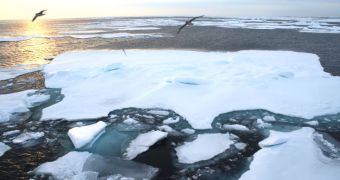Experts at the US National Snow and Ice Data Center (NSIDC) say that they expect the Arctic Ocean to reach its minimum sea ice extent for 2012 within the next couple of days. This usually happens around mid- to late-September, after which time sea ices begin to grow anew.
According to statistics available to date, Arctic sea ice extent was just 3.41 million square kilometers (1.32 million miles) on September 19. This is an extremely low value, significantly smaller than the 4.17 million square kilometers (1.61 million square miles) recorded on September 18, 2007.
Five years ago, scientists recorded the lowest ice extents since 1979. The year was very warm overall, and the melting of vast volumes of ice around the North Pole was just one of the ways in which this became visible.
Since 2007, all years have set records of their own, but it would now appear that 2012 is about to take the crown. Already, values for September 18 are lower than they were five years ago, and NSIDC experts say that there are still several days of melting left.
“Weather conditions near the ice edge heavily influence the timing of the minimum, which has occurred as late as September 23. We are now five days past the 1979 to 2000 average minimum date of September 13,” the team says in a statement.
“The decline has slowed in recent days and the minimum will likely be confirmed any day now,” they add. Right now, ice extents are 760,000 square kilometers (293,000 square miles) below the 2007 level. To get a sense of perspective, this difference in area cover is larger than the surface of Texas.
By comparison to the 1979-2000 interval, current levels are more than 50 percent below average. Since the beginning of the month, the Arctic lost around 19,800 square kilometers (7,600 square miles) of sea ice per day.
“Freeze up has begun over the high latitude Arctic areas, such as the North Pole, and extent has started to increase in the Beaufort Sea region. However, extent is still decreasing on the Atlantic side of the Arctic, leading to the continued overall decline in recent days,” the latest NSIDC report states.
“The Northern Sea Route along the coast of Siberia has been largely free of ice since mid August. This is in contrast with 2007, when a persistent tongue of ice reaching the coast of the Laptev Sea clogged the Northern Sea Route,” the document concludes.

 14 DAY TRIAL //
14 DAY TRIAL //